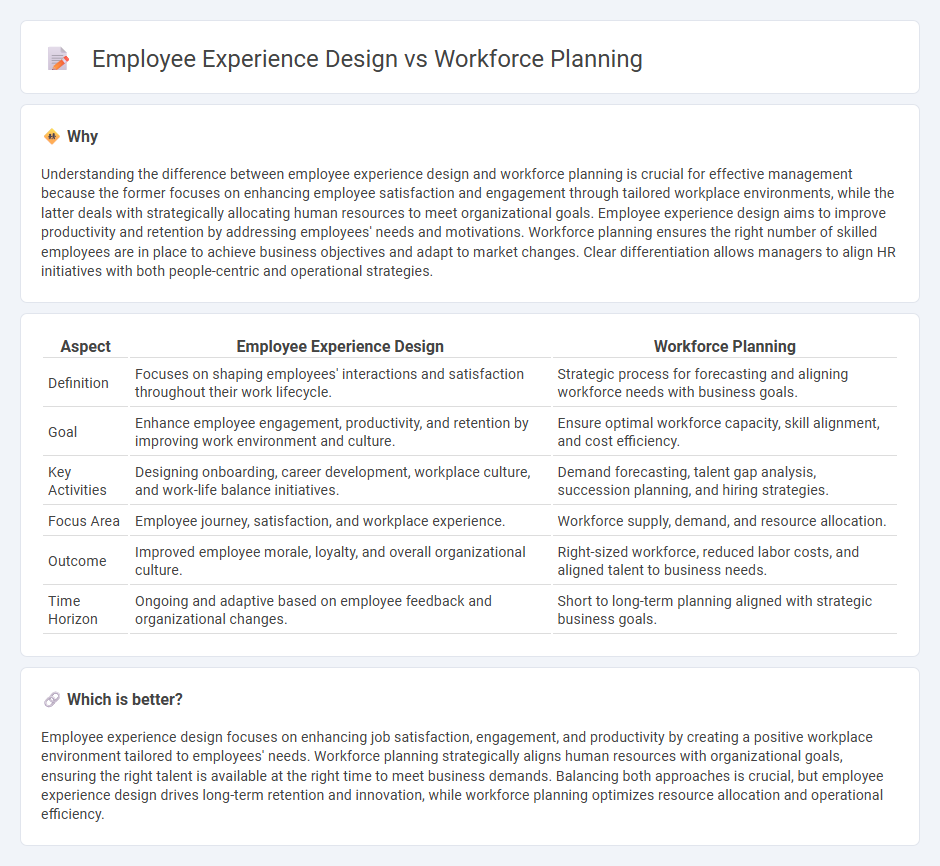
Employee experience design focuses on creating a positive and engaging work environment by optimizing factors such as workplace culture, communication, and employee well-being. Workforce planning involves strategically analyzing and forecasting talent needs to ensure the right number of skilled employees are available to meet future business demands. Explore how integrating employee experience design with workforce planning drives organizational excellence and sustainable growth.
Why it is important
Understanding the difference between employee experience design and workforce planning is crucial for effective management because the former focuses on enhancing employee satisfaction and engagement through tailored workplace environments, while the latter deals with strategically allocating human resources to meet organizational goals. Employee experience design aims to improve productivity and retention by addressing employees' needs and motivations. Workforce planning ensures the right number of skilled employees are in place to achieve business objectives and adapt to market changes. Clear differentiation allows managers to align HR initiatives with both people-centric and operational strategies.
Comparison Table
| Aspect | Employee Experience Design | Workforce Planning |
|---|---|---|
| Definition | Focuses on shaping employees' interactions and satisfaction throughout their work lifecycle. | Strategic process for forecasting and aligning workforce needs with business goals. |
| Goal | Enhance employee engagement, productivity, and retention by improving work environment and culture. | Ensure optimal workforce capacity, skill alignment, and cost efficiency. |
| Key Activities | Designing onboarding, career development, workplace culture, and work-life balance initiatives. | Demand forecasting, talent gap analysis, succession planning, and hiring strategies. |
| Focus Area | Employee journey, satisfaction, and workplace experience. | Workforce supply, demand, and resource allocation. |
| Outcome | Improved employee morale, loyalty, and overall organizational culture. | Right-sized workforce, reduced labor costs, and aligned talent to business needs. |
| Time Horizon | Ongoing and adaptive based on employee feedback and organizational changes. | Short to long-term planning aligned with strategic business goals. |
Which is better?
Employee experience design focuses on enhancing job satisfaction, engagement, and productivity by creating a positive workplace environment tailored to employees' needs. Workforce planning strategically aligns human resources with organizational goals, ensuring the right talent is available at the right time to meet business demands. Balancing both approaches is crucial, but employee experience design drives long-term retention and innovation, while workforce planning optimizes resource allocation and operational efficiency.
Connection
Employee experience design and workforce planning are interconnected through their shared focus on aligning organizational goals with employee needs to enhance productivity and retention. Effective workforce planning leverages insights from employee experience data to forecast talent requirements and optimize staffing models. This integration enables organizations to create a supportive work environment that drives engagement and business performance.
Key Terms
**Workforce Planning:**
Workforce planning involves strategically forecasting and managing talent needs to align with an organization's long-term goals, ensuring the right skills are available at the right time. This process includes analyzing labor market trends, identifying skill gaps, and optimizing workforce allocation to improve productivity and reduce costs. Explore how integrating data analytics enhances workforce planning efficiency and drives business success.
Talent Forecasting
Workforce planning centers on talent forecasting by analyzing labor market trends, skill gaps, and organizational needs to predict future workforce requirements accurately. Employee experience design emphasizes creating engaging environments that attract and retain talent, indirectly supporting forecasting efforts by reducing turnover and enhancing productivity. Explore comprehensive strategies to integrate talent forecasting with employee experience design for optimized workforce outcomes.
Succession Planning
Succession planning within workforce planning focuses on identifying and developing internal talent to ensure leadership continuity and organizational stability. Employee experience design enhances this process by creating engaging, supportive environments that motivate potential successors through personalized learning and career development opportunities. Explore how integrating these strategies can optimize your succession planning outcomes.
Source and External Links
What Is Workforce Planning? Strategies and Benefits - Workforce planning is the process of analyzing an organization's current and future staffing needs, identifying skill and leadership gaps, and developing targeted strategies--such as recruitment, training, or succession planning--to ensure the right talent is available to meet long-term business goals, with ongoing monitoring and adjustment for effectiveness.
Workforce Planning: Definition, Process and Principles - Workforce planning involves determining an organization's strategic direction, analyzing both the internal and external supply of talent, assessing future demand for specific skills and attributes, and developing plans to align workforce capabilities with business objectives and market competition.
Workforce Planning - Workforce planning is a cyclical process of analyzing and forecasting workforce supply and demand, assessing gaps between current capabilities and future needs, designing targeted interventions to close those gaps, and continuously monitoring and refining strategies to ensure the organization has the right people with the right skills in the right roles at the right time.
 dowidth.com
dowidth.com